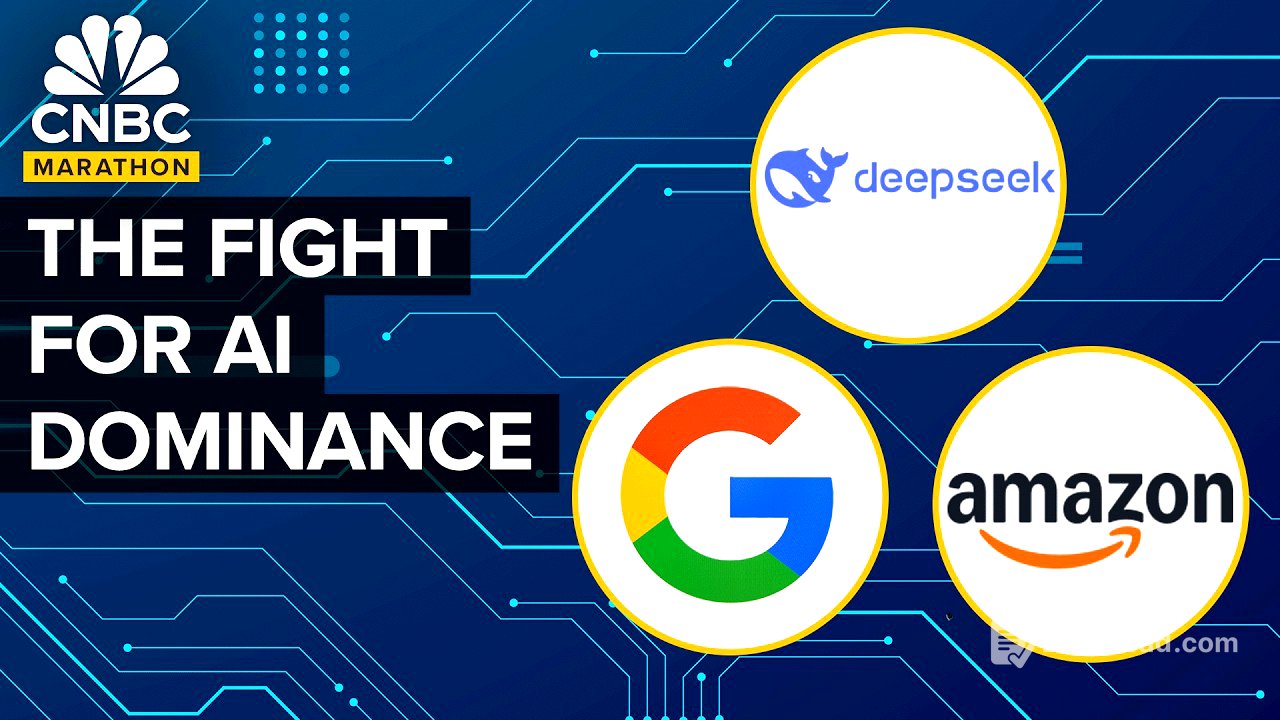TLDR;
This YouTube video by CNBC covers three main topics: China's AI breakthrough with DeepSeek, the rise of AI-powered humanoid robots, and the trend of big tech companies "raiding" AI startups for talent.
- DeepSeek, a Chinese AI lab, has developed an open-source AI model that rivals those of Google and OpenAI at a fraction of the cost.
- Major tech companies like Amazon, Google, Nvidia, Microsoft, and Tesla are investing heavily in AI-powered humanoid robots.
- Big tech companies are strategically hiring talent from AI startups through licensing deals and retention bonuses, effectively acquiring expertise without formal acquisitions.
Introduction [0:00]
The video introduces three key areas in the tech world: China's AI advancements, the rise of AI-powered humanoid robots, and the strategic talent acquisitions by major tech companies from AI startups. It highlights DeepSeek's cost-effective AI model, investments in humanoid robots by companies like Amazon and Tesla, and the talent acquisition strategies employed by Google, Microsoft, and Amazon.
How China’s New AI Model DeepSeek Is Threatening U.S. Dominance [1:17]
China's DeepSeek has introduced a free, open-source AI model that has surpassed some of the most powerful models available, developed by a Chinese research lab, DeepSeek, with significantly less funding, costing only $5.6 million compared to the billions spent by OpenAI and Google. DeepSeek's model has outperformed Meta's Llama, OpenAI's GPT-4o, and Anthropic's Claude Sonnet 3.5 in accuracy across various tests, including math problems, AI evaluations, coding competitions, and bug fixing. Despite U.S. semiconductor restrictions, DeepSeek used Nvidia's less performant H-800s to build its model, demonstrating efficient hardware utilization. The founder of DeepSeek, Liang Wenfeng, operates with the mission to "unravel the mystery of AGI with curiosity," contrasting with the detailed charters of American AI startups. Other Chinese AI models, such as Kai Fu Lee's "Zero One Dot AI" and Alibaba's Qwen, are also making significant strides with limited resources. Eric Schmidt acknowledges that China has rapidly caught up in AI, with DeepSeek being a prime example. The availability of powerful open-source models allows developers to innovate with smaller budgets, challenging the dominance of closed-source leaders like OpenAI. DeepSeek's model, however, has an identity crisis, identifying itself as a GPT-4-based model, leading to questions about emulation versus innovation. The model's efficiency is attributed to distillation, using a large model to train a smaller one cost-effectively, and leveraging available datasets with innovative tweaks. The U.S. government's chip restrictions, intended to slow China's progress, may have inadvertently spurred greater efficiency and creativity. The open-source nature of DeepSeek's model could lead to widespread adoption, potentially undermining U.S. leadership and embedding China more deeply into global tech infrastructure. Concerns arise over the Chinese Communist Party's control of AI narratives, requiring models to adhere to "core socialist values" and censor certain historical events. Perplexity co-founder and CEO Arvind Srinivas notes that China's disadvantage in hardware access has driven them to build more efficient solutions, with DeepSeek's model being 10x cheaper in API pricing than GPT-4. Srinivas was surprised by the clever solutions in DeepSeek's technical paper, including training a mixture of experts model and figuring out floating point-8 bit training. He also notes that DeepSeek trained for only 60 days, which is impressive. Srinivas also notes that it's more dangerous that they have the best open source model, and all the American developers are building on that.
Why Nvidia, Tesla, Amazon And More Are Betting Big On AI-Powered Humanoid Robots [41:40]
Bipedal humanoid robots, like Digit, are gaining attention and investments from major tech companies such as Amazon, Google, Nvidia, Microsoft, and Tesla. These robots use semantic intelligence to interpret commands and make decisions, with Elon Musk predicting Tesla's future depends on them. Proponents argue these robots can solve labor crises by filling dangerous or unwanted jobs and replacing an aging workforce. Generative AI is driving advancements in robotics, enabling robots to perform tasks autonomously through training on real-world data. Big tech companies are partnering to leverage resources for AI development in robotics. Tesla claims its Optimus robots will perform factory tasks by the end of the year and be available for sale by the end of 2025. Agility Robotics' Digit is assisting Amazon in recycling totes, with plans for an app store for robots. Agility is building a factory to produce 10,000 robots per year, primarily for logistics and warehousing. Other startups like Sanctuary AI and Apptronik are developing similar humanoid robots for various tasks. Analysts predict a $38 billion market by 2035, with robots vital for manufacturing, dangerous work, and elderly care. A fully automated labor force could significantly reduce costs and improve manufacturing efficiency. While robots may replace some jobs, proponents suggest new roles will emerge, such as managing robot fleets. Safety is a primary concern, with companies working on collaborative safety standards and regulatory approvals. Cost is another significant hurdle, with efforts to reduce the price for mass adoption. China is a major player in the robotics industry, accounting for over half of global installations. Competitiveness in this space is crucial for the U.S., with concerns over losing the "arms race" to China. Despite roadblocks, the industry is seen as the beginning of a new era, potentially more impactful than the personal computer.
How Google, Microsoft And Amazon Are Raiding AI Startups For Talent [58:48]
Major tech companies like Google, Microsoft, and Amazon are strategically acquiring talent from AI startups without outright acquisitions. Google has brought back Noam Shazeer, a co-founder of Character AI, along with a portion of his employees, through a licensing deal. Microsoft hired Mustafa Suleyman, founder of Inflection, to lead its entire AI unit through a $650 million agreement. Amazon paid $330 million to license Adept's technology and offered $100 million in retention bonuses to employees who joined Amazon. This playbook allows megacaps to quell competition, poach top talent, and skirt regulatory scrutiny. Startups benefit by gaining access to resources like cloud computing and GPUs, while founders avoid the pressure to monetize quickly. However, employees not hired and VC firms may not fully benefit from these deals. Regulators, including the FTC and DOJ, are scrutinizing these deals for anti-competitive practices. Concerns arise over the consolidation of power in the hands of a few large companies, potentially stifling innovation. While these deals may seem like win-win scenarios, they leave behind a shell of a company and some employees, impacting their future prospects.









